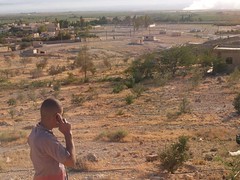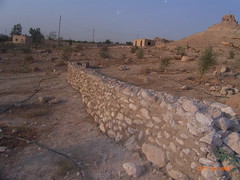When it comes to water, Jordan is one of the poorest countries on the planet, consuming an average of only 200m3 /person/year. The global average is approximately 7,700 m3 and the North American average is on the order of 110,000 m3 .
Al Jufah is located in the Dead Sea Valley several hundred meters below sea level. The average rainfall for the area is 100-150mm per year which usually falls in just one or two rain events. The summer temperature often exceeds 40°C and the defining characteristic of this bioregion, as with all arid regions, is an average evaporation exceeding precipitation. Water is a major issue for the region, and water harvesting design will be vital to success under these conditions.
During a visit to Jordan in Late 2007 Nadia, Abu Yahai, Lawton designed and implemented three on-contour rock walls (swale walls) on the site, one of which can be seen in the photo above. The walls were back filled and covered with a layer of topsoil.
These walls will function as soakage water harvesting features and planting sites. Other site infrastructure includes a gravity fed drip irrigation system, small holding tank, low perimeter fence and a small concrete block structure.
The long-term goals of PRI Jordan are to establish sustainable arid land living systems, which can be affordably replicated by members of the local community. The primary short term objective for the coming months will be planting and maintaining perennial plant systems along all three swale walls and fence lines. These guilds will included both support and crop species. Plantings regimes will resemble those established by Geoff during Greening the desert, 2001. In the future these perennial systems will provide micro-climatic stability on the site, giving shade and wind protection, holding soil moisture and building organic matter. As the system develops the site will become a more comfortable living environment for human habitation.
All plantings will need to be in the ground by the end of April, as the weather is too hot and dry after this time. Through the course of the summer months it will be crucial to keep the plants irrigated and well mulched to survive the season. The summer construction of a straw bale house may take place if more funding for the project can be sourced.
Raising local awareness and empowerment will be the most important aspect of PRI Jordan. It is important to demonstrate practical solutions for local difficulties involving water, food (nutrition), fuel, housing and waste management. Empowerment of the local population is vital to the maintenance of local stability and sustainable long-term success of any community. There is a strong historical presence of efficient water use and water harvesting design throughout the region. The Nabetean culture was second to none when it comes to dry land agricultural design and many aspects of permaculture design take a page directly out of this cultural history.
It is the hope of PRI Jordan to rekindle the success of these traditional systems, reducing the dependence on modernization and industrialized systems.
Will run-away climate change make drought permanent?
18 years ago






2 comments:
Wow, hope you guys are looking after yourselves. You are such power houses. How are the older works holding up?
Love to you both.
Hooray for more greening the desert. Put all those soldiers to work healing the soil.
(Glad to see a new post. We need more on-line permaculture case studies.)
Post a Comment